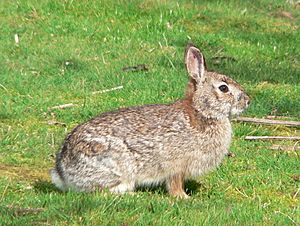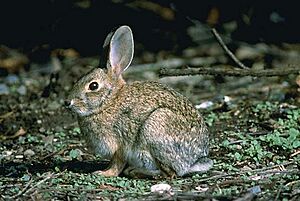Brush rabbit facts for kids
The brush rabbit (Sylvilagus bachmani) is a small type of cottontail rabbit that lives along the western coast of North America. You can find them from the Columbia River in Oregon all the way down to the southern tip of the Baja California peninsula. They also live as far east as the Sierra Nevada and Cascade Range mountains.
Quick facts for kids Brush rabbit |
|
|---|---|
 |
|
| Brush rabbit (Finley National Wildlife Refuge) | |
| Conservation status | |
| Scientific classification | |
| Genus: |
Sylvilagus
|
| Species: |
bachmani
|
 |
|
| Brush rabbit range | |
Contents
What do Brush Rabbits Look Like?
Brush rabbits are small, with short legs and a short tail. Their fur is dark gray on their sides and back. Their belly and the underside of their tail are pale gray. Most of their whiskers are black, but some have white tips. Adult brush rabbits are usually about 30 to 37 centimeters (12 to 14.5 inches) long. They weigh between 511 and 917 grams (18 to 32 ounces).
There are several different kinds of brush rabbits, called subspecies. These different types live in specific areas, like Oregon, California, and Baja California. Sometimes, brush rabbits have mixed with other rabbit types. This can make them look a bit different, like having a white tail in some parts of Oregon.
Where do Brush Rabbits Live?
Brush rabbits need places with lots of thick bushes and brambles. These dense areas give them cover and safety. They often create many small paths and runways through the thick brush. Brush rabbits don't dig their own burrows. Instead, they might use burrows made by other animals. Their home area is usually quite small, less than 2,000 square meters.
These rabbits mostly live in chaparral areas, which are dry lands with shrubs. You can also find them in oak forests and conifer (pine tree) habitats. In some places, like the San Francisco Bay Area, brush rabbits prefer to stay at the edge of the brushy areas. They don't use open grassy areas as much. They might use grassy spots more when it's wet and plants are growing.
Where are Brush Rabbits Found?
Brush rabbits live only along the Pacific coast. Their range stretches from the Columbia River in the north to the very tip of Baja California, Mexico, in the south. You won't find them east of the Sierra Nevada and Cascade mountain ranges.
How do Brush Rabbits Behave?
Brush rabbits usually look for food alone or in small groups. You might see them warming themselves in the sun during the mid-morning. Otherwise, they are quite shy and careful. If they get scared, they will thump the ground with their back feet.
These rabbits mostly eat grasses and small flowering plants, especially green clover. They also enjoy eating berries and nibbling on shrubs.
Male brush rabbits tend to have larger home areas than females. This is especially true in May, when females move around less. A male's home range is usually about 4,000 square meters (1 acre). A female's home range is about 2,000 square meters (0.5 acres). These areas aren't always perfectly round. They often follow paths that connect important spots within the brush.
Even if several rabbits are eating in the same area, they usually keep some distance from each other. If they get too close, they might chase each other. Female brush rabbits tend to avoid overlapping their home areas. Males, however, often have overlapping areas. This might mean that females are more protective of their space. Sometimes, groups of brush rabbits might help each other spot predators, but this isn't fully proven.
How do Brush Rabbits Have Babies?
The time of year when brush rabbits have babies changes depending on where they live. In Oregon, they breed from February to August. In California, it's from December to May or June. The number of babies in a litter also varies. In Oregon, a mother usually has about 2 or 3 babies. In northern and central California, it's about 3 or 4 babies. In west-central California, it's usually 4 babies.
Brush rabbits are not as fast at having babies as some other rabbit types. They usually have about 15 young in five to six litters each year. A female brush rabbit is pregnant for about 22 days. When the babies are born, they are helpless and need their mother's care.
Who are the Brush Rabbit's Predators?
Many animals hunt brush rabbits. These include cougars, coyotes, foxes, bobcats, weasels, and different kinds of raptors (like hawks and eagles) and snakes.
To stay safe, brush rabbits have a few tricks. If they are in thick bushes, they will stay very still. If they are in open areas, they will run in a zig-zag pattern to confuse predators. They can also climb onto low branches to escape danger.
Brush Rabbits and People
People don't usually hunt brush rabbits for food. This is probably because they are quite small. They also don't cause much damage to crops or other human developments.
Most brush rabbit populations are stable, meaning their numbers are healthy. However, one special type, the riparian brush rabbit (Sylvilagus bachmani riparius), is an endangered species. This means it is at high risk of disappearing. This subspecies used to be common along the San Joaquin River and Stanislaus River. Now, only a few hundred are left in Caswell Memorial State Park. Efforts are being made to bring them back to the nearby San Joaquin River National Wildlife Refuge. Their habitat along rivers has been destroyed, which has hurt their population.
Myxomatosis Virus
Brush rabbits naturally carry a virus called the myxoma virus. This virus is a type of poxvirus. For brush rabbits, this virus usually causes only a mild sickness. However, for European (pet) rabbits, it causes a very serious and often deadly disease called myxomatosis. This disease usually spreads from one rabbit to another through biting insects, like mosquitoes.
See also
 In Spanish: Conejo matorralero para niños
In Spanish: Conejo matorralero para niños



